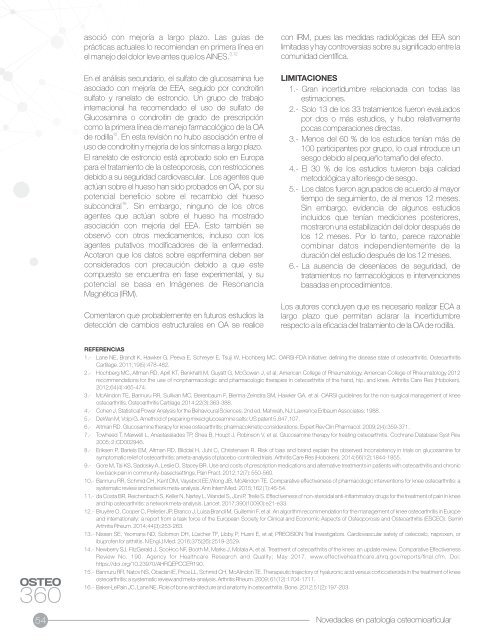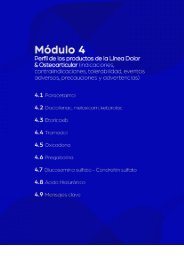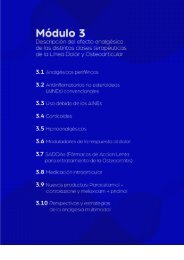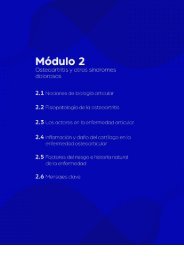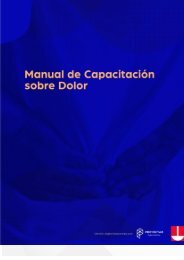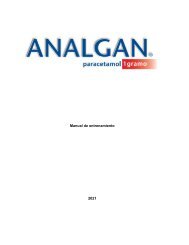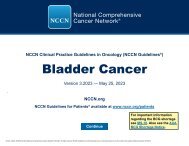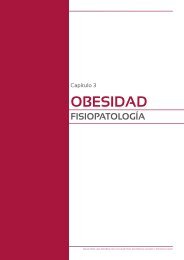Create successful ePaper yourself
Turn your PDF publications into a flip-book with our unique Google optimized e-Paper software.
asoció con mejoría a largo plazo. Las guías de<br />
prácticas actuales lo recomiendan en primera línea en<br />
3,12<br />
el manejo del dolor leve antes que los AINES.<br />
En el análisis secundario, el sulfato de glucosamina fue<br />
asociado con mejoría de EEA, seguido por condroitin<br />
sulfato y ranelato de estroncio. Un grupo de trabajo<br />
internacional ha recomendado el uso de sulfato de<br />
Glucosamina o condroitin de grado de prescripción<br />
como la primera línea de manejo farmacológico de la OA<br />
12<br />
de rodilla . En esta revisión no hubo asociación entre el<br />
uso de condroitin y mejoría de los síntomas a largo plazo.<br />
El ranelato de estroncio está aprobado solo en Europa<br />
para el tratamiento de la osteoporosis, con restricciones<br />
debido a su seguridad cardiovascular. Los agentes que<br />
actúan sobre el hueso han sido probados en OA, por su<br />
potencial beneficio sobre el recambio del hueso<br />
16<br />
subcondral . Sin embargo, ninguno de los otros<br />
agentes que actúan sobre el hueso ha mostrado<br />
asociación con mejoría del EEA. Esto también se<br />
observó con otros medicamentos, incluso con los<br />
agentes putativos modificadores de la enfermedad.<br />
Acotaron que los datos sobre esprifermina deben ser<br />
considerados con precaución debido a que este<br />
compuesto se encuentra en fase experimental, y su<br />
potencial se basa en Imágenes de Resonancia<br />
Magnética (IRM).<br />
Comentaron que probablemente en futuros estudios la<br />
detección de cambios estructurales en OA se realice<br />
con IRM, pues las medidas radiológicas del EEA son<br />
limitadas y hay controversias sobre su significado entre la<br />
comunidad científica.<br />
LIMITACIONES<br />
1.- Gran incertidumbre relacionada con todas las<br />
estimaciones.<br />
2.- Solo 13 de los 33 tratamientos fueron evaluados<br />
por dos o más estudios, y hubo relativamente<br />
pocas comparaciones directas.<br />
3.- Menos del 60 % de los estudios tenían más de<br />
100 participantes por grupo, lo cual introduce un<br />
sesgo debido al pequeño tamaño del efecto.<br />
4.- El 30 % de los estudios tuvieron baja calidad<br />
metodológica y alto riesgo de sesgo.<br />
5.- Los datos fueron agrupados de acuerdo al mayor<br />
tiempo de seguimiento, de al menos 12 meses.<br />
Sin embargo, evidencia de algunos estudios<br />
incluidos que tenían mediciones posteriores,<br />
mostraron una estabilización del dolor después de<br />
los 12 meses. Por lo tanto, parece razonable<br />
combinar datos independientemente de la<br />
duración del estudio después de los 12 meses.<br />
6.- La ausencia de desenlaces de seguridad, de<br />
tratamientos no farmacológicos e intervenciones<br />
basadas en procedimientos.<br />
Los autores concluyen que es necesario realizar ECA a<br />
largo plazo que permitan aclarar la incertidumbre<br />
respecto a la eficacia del tratamiento de la OA de rodilla.<br />
OSTEO<br />
<strong>360</strong><br />
54<br />
REFERENCIAS<br />
1.- Lane NE, Brandt K, Hawker G, Peeva E, Schreyer E, Tsuji W, Hochberg MC. OARSI-FDA initiative: defining the disease state of osteoarthritis. <strong>Osteo</strong>arthritis<br />
Cartilage. <strong>20</strong>11;19(5):478-482.<br />
2.- Hochberg MC, Altman RD, April KT, Benkhalti M, Guyatt G, McGowan J, et al; American College of Rheumatology. American College of Rheumatology <strong>20</strong>12<br />
recommendations for the use of nonpharmacologic and pharmacologic therapies in osteoarthritis of the hand, hip, and knee. Arthritis Care Res (Hoboken).<br />
<strong>20</strong>12;64(4):465-474.<br />
3.- McAlindon TE, Bannuru RR, Sullivan MC, Berenbaum F, Bierma-Zeinstra SM, Hawker GA, et al. OARSI guidelines for the non-surgical management of knee<br />
osteoarthritis. <strong>Osteo</strong>arthritis Cartilage.<strong>20</strong>14;22(3):363-388.<br />
4.- Cohen J. Statistical Power Analysis for the Behavioural Sciences. 2nd ed. Mahwah, NJ: Lawrence Erlbaum Associates; 1988.<br />
5.- DeWan M, Volpi G. Amethod of preparing mixed glucosamine salts: US patent 5,847,107.<br />
6.- Altman RD. Glucosamine therapy for knee osteoarthritis: pharmacokinetic considerations. Expert Rev Clin Pharmacol. <strong>20</strong>09;2(4):359-371.<br />
7.- Towheed T, Maxwell L, Anastassiades TP, Shea B, Houpt J, Robinson V, et al. Glucosamine therapy for treating osteoarthritis. Cochrane Database Syst Rev.<br />
<strong>20</strong>05; 2:CD002946.<br />
8.- Eriksen P, Bartels EM, Altman RD, Bliddal H, Juhl C, Christensen R. Risk of bias and brand explain the observed inconsistency in trials on glucosamine for<br />
symptomatic relief of osteoarthritis: ameta-analysis of placebo-controlled trials. Arthritis Care Res (Hoboken). <strong>20</strong>14;66(12):1844-1855.<br />
9.- Gore M, Tai KS, Sadosky A, Leslie D, Stacey BR. Use and costs of prescription medications and alternative treatments in patients with osteoarthritis and chronic<br />
low back pain in community-based settings. Pain Pract. <strong>20</strong>12;12(7): 550-560.<br />
10.- Bannuru RR, Schmid CH, Kent DM, Vaysbrot EE,Wong JB, McAlindon TE. Comparative effectiveness of pharmacologic interventions for knee osteoarthritis: a<br />
systematic review and network meta-analysis. Ann Intern Med. <strong>20</strong>15;162 (1):46-54.<br />
11.- da Costa BR, Reichenbach S, Keller N, Nartey L, Wandel S, Jüni P, Trelle S. Effectiveness of non-steroidal anti-inflammatory drugs for the treatment of pain in knee<br />
and hip osteoarthritis: a network meta-analysis. Lancet. <strong>20</strong>17;390(10090):e21-e33.<br />
12.- Bruyère O, Cooper C, Pelletier JP, Branco J, Luisa Brandi M, Guillemin F, et al. An algorithm recommendation for the management of knee osteoarthritis in Europe<br />
and internationally: a report from a task force of the European Society for Clinical and Economic Aspects of <strong>Osteo</strong>porosis and <strong>Osteo</strong>arthritis (ESCEO). Semin<br />
Arthritis Rheum. <strong>20</strong>14;44(3):253-263.<br />
13.- Nissen SE, Yeomans ND, Solomon DH, Lüscher TF, Libby P, Husni E, et al; PRECISION Trial Investigators. Cardiovascular safety of celecoxib, naproxen, or<br />
ibuprofen for arthritis. N Engl J Med. <strong>20</strong>16;375(26):2519-2529.<br />
14.- Newberry SJ, FitzGerald J, SooHoo NF, Booth M, Marks J, Motala A, et al. Treatment of osteoarthritis of the knee: an update review. Comparative Effectiveness<br />
Review No. 190. Agency for Healthcare Research and Quality; May <strong>20</strong>17. www.effectivehealthcare.ahrq.gov/reports/final.cfm. Doi:<br />
https://doi.org/10.23970/AHRQEPCCER190.<br />
15.- Bannuru RR, Natov NS, Obadan IE, Price LL, Schmid CH, McAlindon TE. Therapeutic trajectory of hyaluronic acid versus corticosteroids in the treatment of knee<br />
osteoarthritis: a systematic review and meta-analysis. Arthritis Rheum. <strong>20</strong>09; 61(12):1704-1711.<br />
16.- Baker-LePain JC, Lane NE. Role of bone architecture and anatomy in osteoarthritis. Bone. <strong>20</strong>12;51(2):197-<strong>20</strong>3.<br />
Novedades en patología osteomioarticular


